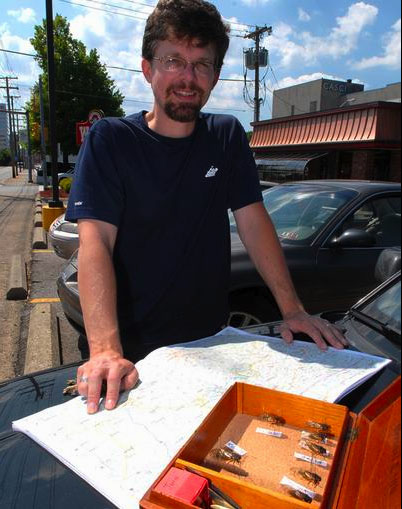I study speciation and species distributions, using cicada species as model organisms. I’m particularly interested in the consequences of secondary contact and the ecological correlates of species boundaries and have worked extensively on mating signals and their exploitation by predators and parasites. I also lead a crowdsourcing project to track periodical cicada emergences in the eastern United States.
Making Modern Maps: A National Geographic Society sponsored project
Visit the project website here!
The periodical cicadas (Magicicada spp.) of Eastern North America have the potential to answer general questions concerning speciation, species boundaries, and postglacial biogeography. Many of these questions are most effectively addressed with accurate maps of periodical cicada emergences. Yet although crude maps of periodical cicadas have existed for over a century, many current maps of these insects are only modernizations of these earlier maps, and their inaccuracies or errors limit their utility.

Modern transportation, highly accurate base maps, GPS technology, and a better understanding of periodical cicada biology provide unprecedented opportunities for accurately mapping Magicicada populations. To date, we have surveyed and mapped over 10,000 localities within periodical cicada emergences, using detailed base maps and GPS technology, such as the custom GPS datalogger pictured below.



This video shows how the datalogger may be used to create detailed maps.
Why map periodical cicadas?
Periodical cicada emergences capture popular attention. When European colonists first encountered these insects, they were puzzled. Emergences seemed unpredictable, and over the years, the insects appeared to move across the landscape as if they were plagues of locusts.
In response to this confusion, natural historians began to record the dates and locations of emergences. Early efforts to compile this information into maps demonstrated that there was a clear, predictable pattern to emergences: In any given area, adult periodical cicadas emerge only once every 13 or 17 years, they are consistent in their life cycles, and populations (or “broods”) in different regions are not synchronized.
Currently there are 7 recognized species, 12 distinct 17-year broods, and 3 distinct 13-year broods, along with 2 known extinct broods, found east of the Great Plains and south of the Great Lakes, to the Florida Panhandle. From this bewildering mix, several patterns have emerged:
- Most of the complex spatial and temporal relationships of periodical cicada broods and species must be less than 10,000 years old, because much of the current range of periodical cicadas in the eastern, Appalachian, and Midwestern U.S. would have been unsuitable for periodical cicadas during and for substantial periods following the Wisconsin glaciation (see Watts 1983; Webb 1981).
- Permanent life cycle changes lead to species formation, while temporary life cycle changes lead to brood formation in Magicicada. Each Magicicada species is most closely related to another with a different life cycle, a pattern that suggests multiple speciation events involving permanent life cycle change (Cooley et al. 2001; Marshall and Cooley 2000; Marshall et al. 2003; Simon et al. 2000). By contrast, environmental miscues of life cycles have the potential to form broods without permanently altering life cycles (Kritsky and Simon 1996; White and Lloyd 1979; Young 1958).
- Geographic distributions hold the key to understanding life cycle change in Magicicada. One instance of allochronic speciation, the formation of the 13-year species M. neotredecim from the 17-year species M. septendecim was identified on the basis of a striking biogeographic pattern of reproductive character displacement (Cooley et al. 2001; Marshall and Cooley 2000; Simon et al. 2000). The temporal and biogeographic relationships of 17-year broods suggest a scheme in which geographically adjacent broods are more closely related than distant broods (Alexander and Moore 1962; Marlatt 1923; Young 1958) and in which broods gave rise to other broods via simple 1- or 4- year temporary life cycle accelerations (Lloyd and Dybas 1966; Simon and Lloyd 1982).
Although maps are an important tool for addressing such questions, most current distribution maps of periodical cicadas trace their ancestry to C. M. Marlatt’s (1923) 19th century compilations of historical emergence records. Unfortunately, these maps and their derivatives tend to overestimate periodical cicada range limits, so they can provide misleading answers to important questions (Marshall 2001). The questions involved are not trivial: Periodical cicada responses to deglaciation may provide insights into the possibility that they are useful for monitoring forest and ecosystem health (see Cooley et al. 2004), while the biogeography of broods and species may provide critical insights into the general nature of species, speciation processes, and gene flow between species.
Other research projects:
My current research includes closely related projects concerning the 13- and 17-year periodical cicadas of eastern North America. Periodical cicadas are divided into species, life cycles, broods (or year-classes), and populations. Almost every year, periodical cicadas emerge somewhere in eastern North America, making them excellent research organisms.
- Speciation and sexual selection in periodical cicadas.
I was the co-discoverer of a cryptic periodical cicada species, Magicicada neotredecim, that exhibits a striking pattern of reproductive character displacement where it is sympatric and synchronic with the species M. tredecim. The incompatible sexual signals of these species reduce opportunities for gene flow and provide a rare example of insect premating isolation mediated by song pitch. These signals have also been exploited by an entomopathogenic fungus. - Distribution and abundance of Magicicada.
Understanding the distributions of periodical cicada species and broods is key to formulating and testing hypotheses for their formation and evolutionary histories. Although crude maps of periodical cicadas have existed for over a century, many current maps of these insects are only modernizations of relatively inaccurate 19th century maps. I am currently leading a project to refine data collection methods, create entirely new, highly detailed georeferenced maps based on both original and crowdsourced data. - Responses of Magicicada to climate change.
The distributional data collected for creating entirely new, highly detailed georeferenced maps are the basis of Species Distribution Models (SDM) and SDM-based tests of hypotheses for brood range changes. In a series of manuscripts in preparation, these models will be used to develop hypotheses concerning glacial refugia and to explore predictions about how these insects will respond to climate change. - Population structure and life cycle evolution in periodical cicadas.
In collaboration with Teiji Sota of Kyoto University and Jin Yoshimura of Shizuoka University, Hamamatsu Japan, I am working to develop phylogeographic hypotheses for relationships among periodical cicada broods and species, to be compared to the Species Distribution Models under development. Our collaboration also involves developing mathematical models of life cycle evolution in periodical cicadas. Periodical cicada species have either 13- or 17-year life cycles, and each species appears most closely related to one with the other life cycle, a pattern best explained by multiple allochronic speciation events. The life-cycle architecture of 17-year periodical cicadas appears to differ from that of 13-year periodical cicadas by the addition of a 4-year period of dormancy or delayed growth. Thus, life cycle switching and some speciation events in periodical cicadas may have relatively simple underlying explanations. While the long life cycles of these animals makes experimental manipulation difficult, theoretical treatment of minority life cycles as Allee effects has been a productive avenue of research for us.
Future research directions:
The methods and approaches I use are generally applicable to any singing insects, and many interesting questions await investigation. For example, some authors consider the genus Okanagana Distant 1905 to be the most speciose of North American cicada genera. Although they seem to span the North American continent, little natural history or distributional information exists concerning these cicadas. Recent work suggests that the North American genus Okanagana and the European genus Tibicina are synonymic, forming one widespread and speciose genus with a Nearctic distribution. If so, then biogeographic patterns among the members of this species group should reflect Nearctic glacial history, similar to the patterns expected in periodical cicadas and on a larger scale than our research group has found for the New Zealand genera Kikihia and Maoricicada. My preliminary work (mtDNA sequence) with this genus suggests that the Tibicina–Okanagana complex is divided into a European and two North American clades. Moreover, Tibicina may be of North American origin, contrary to conventional wisdom that Okanagana is of European origin. Preliminary work on this project is ongoing.
Examples of student research projects
Undergraduate researchers have participated in all of my projects. Examples of undergraduate research projects include Adrianne Smits’ study of the relationship between female oviposition and underground nymph density and Kathryn Fontaine’s project investigating the surprisingly common occurrence of paternal mitochondrial leakage in F1 hybrid periodical cicadas.
Literature
Alexander, R. D., and T. E. Moore. 1962. The evolutionary relationships of 17-year and 13-year cicadas, and three new species. (Homoptera: Cicadidae, Magicicada). University of Michigan Museum of Zoology Miscellaneous Publication 121:1-59.
Cooley, J. R. 2004. Asymmetry and mating success in a periodical cicada, Magicicada septendecim (Hemiptera: Cicadidae). Ethology 110:745-759.
Cooley, J. R. 2007. Decoding Asymmetries in Reproductive Character Displacement. Proceedings of the Academy of Natural Sciences of Philadelphia 156.
Cooley, J. R. 2015. The distribution of periodical cicada (Magicicada) Brood I in 2012, with previously unreported disjunct populations (Hemiptera: Cicadidae). The American Entomologist 61:52-57.
Cooley, J. R., G. S. Hammond, and D. C. Marshall. 1998. Effects of enamel paint on the behavior and survival of the periodical cicada, Magicicada septendecim (Homoptera) and the lesser migratory grasshopper, Melanoplus sanguinipes (Orthoptera). Great Lakes Entomologist 31:161-168.
Cooley, J. R., G. Kritsky, M. D. Edwards, J. D. Zyla, D. C. Marshall, K. B. R. Hill, G. J. Bunker, M. L. Neckermann, and C. Simon. 2011. Periodical cicadas (Magicicada spp.): The distribution of Broods XIV in 2008 and “XV” in 2009. The American Entomologist 57:144-151.
Cooley, J. R., G. Kritsky, D. C. Marshall, K. B. R. Hill, G. J. Bunker, M. L. Neckermann, J. Yoshimura, J. E. Cooley, and C. Simon. 2016. A GIS-based map of periodical cicada Brood XIII in 2007, with notes on adjacent populations of Broods III and X (Hemiptera: Magicicada spp.). The American Entomologist 62:241-246.
Cooley, J. R., G. Kritsky, J. D. Zyla, M. J. Edwards, C. Simon, D. C. Marshall, K. B. R. Hill, and R. Krauss. 2009. The distribution of periodical cicada Brood X. The American Entomologist 55:106-112.
Cooley, J. R., and D. C. Marshall. 2001. Sexual signaling in periodical cicadas, Magicicada spp. (Hemiptera: Cicadidae). Behaviour 138:827-855.
Cooley, J. R., and D. C. Marshall. 2004. Thresholds or comparisons: Mate choice criteria and sexual selection in a periodical cicada, Magicicada septendecim (Hemiptera: Cicadidae). Behaviour 141:647-673.
Cooley, J. R., D. C. Marshall, K. B. R. Hill, and C. Simon. 2006. Reconstructing asymmetrical reproductive character displacement in a periodical cicada contact zone. Journal Of Evolutionary Biology 19:855-868.
Cooley, J. R., D. C. Marshall, A. F. Richards, R. D. Alexander, M. D. Irwin, J. R. Coelho, and C. Simon. 2013a. The distribution of periodical cicada Brood III in 1997, with special emphasis on Illinois (Hemiptera: Magicicada spp.). The American Entomologist 59:9-14.
Cooley, J. R., D. C. Marshall, and C. Simon. 2004. The historical contraction of periodical cicada Brood VII (Hemiptera: Cicadidae: Magicicada). Journal of the New York Entomological Society 112:198-204.
Cooley, J. R., M. L. Neckermann, G. J. Bunker, D. C. Marshall, and C. Simon. 2013b. At the limits: Habitat suitability modeling of Northern 17-year periodical cicada extinctions (Hemiptera: Magicicada spp.). Global Ecology and Biogeography 22:410-421.
Cooley, J. R., C. Simon, C. Maier, D. C. Marshall, J. Yoshimura, S. M. Chiswell, M. D. Edwards, C. W. Holliday, R. Grantham, J. D. Zyla, R. L. Sanders, M. L. Neckermann, and G. J. Bunker. 2015. The distribution of periodical cicada (Magicicada) Brood II in 2013: Disjunct emergences suggest complex origins. The American Entomologist 61:245-251.
Cooley, J. R., C. Simon, and D. C. Marshall. 2003. Temporal separation and speciation in periodical cicadas. Bioscience 53:151-157.
Cooley, J. R., C. Simon, D. C. Marshall, K. Slon, and C. Ehrhardt. 2001. Allochronic speciation, secondary contact, and reproductive character displacement in periodical cicadas (Hemiptera: Magicicada spp.): genetic, morphological, and behavioural evidence. Molecular Ecology 10:661-671.
Fontaine, K. M., J. R. Cooley, and C. Simon. 2007. Evidence for paternal leakage in hybrid periodical cicadas (Hemiptera: Magicicada spp.). PLos One 9:e892.
Ito, H., S. Kakishima, T. Uehara, S. Morita, T. Koyama, T. Sota, J. R. Cooley, and J. Yoshimura. 2015. Evolution of periodicity in periodical cicadas. Scientific Reports 5:14094.
Koyama, T., H. Ito, T. Fujisawa, H. Ikeda, S. Kakishima, J. R. Cooley, C. Simon, J. Yoshimura, and T. Sota. 2016. Genomic divergence and lack of introgressive hybridization between two 13-year periodical cicadas supports life-cycle switching in the face of climate change. Molecular Ecology 25:5543-5556.
Koyama, T., H. Ito, S. Kakishima, J. Yoshimura, J. R. Cooley, C. Simon, and T. Sota. 2015. Geographic body size variation in the periodical cicadas (Magicicada): Implications for life cycle divergence and local adaptation. Journal Of Evolutionary Biology 28:1270-1277.
Kritsky, G., and S. Simon. 1996. The unexpected 1995 emergence of periodical cicadas (Homoptera: Cicadidae: Magicicada spp.) in Ohio. Ohio Journal Of Science 96:27-28.
Lloyd, M., and H. S. Dybas. 1966. The Periodical Cicada Problem. II. Evolution. Evolution 20:466-505.
Marlatt, C. 1923. The Periodical Cicada. United Stated Department of Agriculture, Bureau of Entomology Bulletin 71
Marshall, D. C. 2001. Periodical cicada (Homoptera: Cicadidae) life-cycle variations, the historical emergence record, and the geographic stability of brood distributions. Annals Of The Entomological Society Of America 94:386-399.
Marshall, D. C., and J. R. Cooley. 2000. Reproductive character displacement and speciation in periodical cicadas, with description of a new species, 13-year Magicicada neotredecim. Evolution 54:1313-1325.
Marshall, D. C., J. R. Cooley, R. D. Alexander, and T. E. Moore. 1996. New records of Michigan Cicadidae (Homoptera), with notes on the use of songs to monitor range changes. Great Lakes Entomologist 29:165-169.
Marshall, D. C., J. R. Cooley, and K. B. R. Hill. 2011a. Developmental plasticity in Magicicada: Thirteen year cicadas emerging in seventeen and twenty-one years (Hemiptera: Cicadidae). Annals Of The Entomological Society Of America 104:443-450.
Marshall, D. C., J. R. Cooley, and C. Simon. 2003. Holocene climate shifts, life-cycle plasticity, and speciation in periodical cicadas: A reply to Cox and Carlton. Evolution 57:433-437.
Simon, C., and M. Lloyd. 1982. Disjunct synchronic population of 17-year periodical cicadas: Relicts or evidence of polyphyly? Journal of the New York Entomological Society 110:275-301.
Simon, C., J. Tang, S. Dalwadi, G. Staley, J. Deniega, and T. R. Unnasch. 2000. Genetic Evidence for Assortative Mating between 13-Year Cicadas and Sympatric “17-Year Cicadas with 13-Year Life Cycles” Provides Support for Allochronic Speciation. Evolution 54:1326-1336.
Smits, A., J. R. Cooley, and E. Westerman. 2010. Twig to Root: Eggnest density and underground nymph distribution in a periodical cicada (Hemiptera: Magicicada septendecim L.) Entomologica Americana 116:73-77.
Sota, T., S. Yamamoto, J. R. Cooley, K. B. R. Hill, C. Simon, and J. Yoshimura. 2013. Different histories of divergence into 13- and 17-year life cycles among three periodical cicada lineages. Proceedings of the National Academy of Sciences of the United States of America 110:6919-6924.
Tanaka, Y., J. Yoshimura, C. Simon, J. R. Cooley, and K.-i. Tainaka. 2009. The Allee effect in the selection for prime-numbered cycles in periodical cicadas. Proceedings of the National Academy of Sciences of the United States of America 106:8975-8979.
Watts, W. A. 1983. Vegetational history of the eastern United States 25,000 to 10,000 years ago. Pp. 294-310 in H. E. Wright and S. C. Porter, eds. Late Quaternary Environments of the United States. University of Minnesota Press, Minneapolis.
Webb, T. I. 1981. The past 11,000 years of vegetational change in Eastern North America. Bioscience 31:501-506.
White, J., and M. Lloyd. 1979. 17-Year Cicadas Emerging After 18 Years: A New Brood? Evolution 33:1193-1199.
Young, F. N. 1958. Some facts and theories about the broods and periodicity of the periodical cicadas. Proceedings of the Indiana Academy of Sciences 68:164-170.